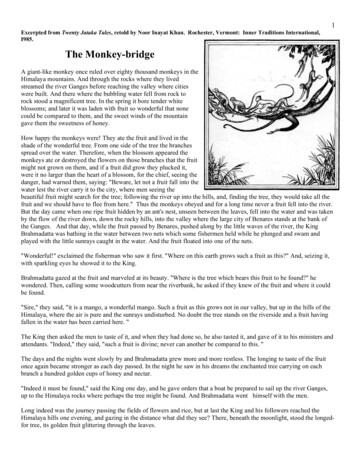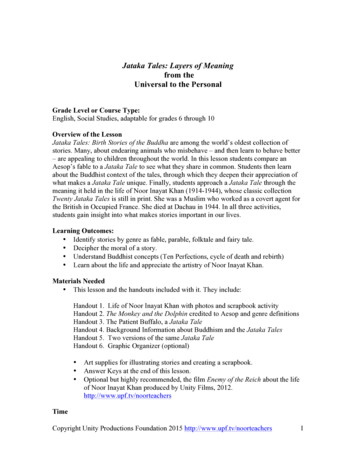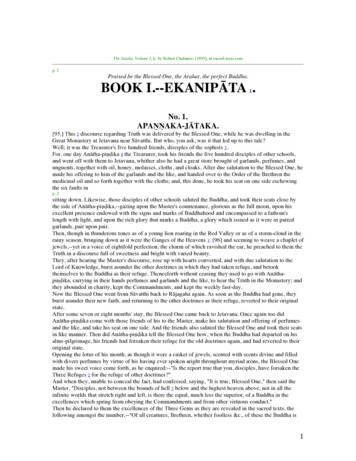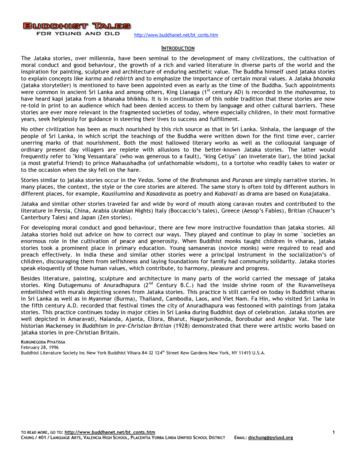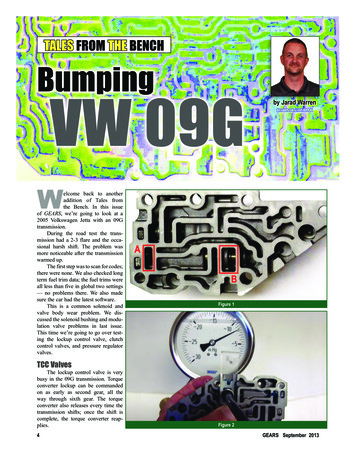
Transcription
Bumping VW 09GTALES FROM THE BENCHBumpingVW 09Gby Jarad Warrenmembers.atra.comWelcome back to anotheraddition of Tales fromthe Bench. In this issueof GEARS, we’re going to look at a2005 Volkswagen Jetta with an 09Gtransmission.During the road test the transmission had a 2-3 flare and the occasional harsh shift. The problem wasmore noticeable after the transmissionwarmed up.The first step was to scan for codes;there were none. We also checked longterm fuel trim data; the fuel trims wereall less than five in global two settings— no problems there. We also madesure the car had the latest software.This is a common solenoid andvalve body wear problem. We discussed the solenoid bushing and modulation valve problems in last issue.This time we’re going to go over testing the lockup control valve, clutchcontrol valves, and pressure regulatorvalves.ABFigure 1TCC ValvesThe lockup control valve is verybusy in the 09G transmission. Torqueconverter lockup can be commandedon as early as second gear, all theway through sixth gear. The torqueconverter also releases every time thetransmission shifts; once the shift iscomplete, the torque converter reapplies.41tech-jarad.indd 4Figure 2GEARS September 20138/30/13 12:57 PM
SOS TranstarFINAL.pdf16/13/122:20 PMCMYCMMYCYCMYKtranstar 712.indd 26/15/12 2:51 AM
Bumping VW 09GLet’s vacuum and wet airtest the TCC control valve:Test location A is the TCCcontrol sleeve and valve. Testlocation B is the control valvebore (figure 1).When adjusting yourvacuum tester, remember:You should have 5 Hg withan 0.035” orifice, and 25 Hgwith no leaks.The vacuum test on location A indicated the sleeve wasgood. But at test location B thecontrol valve bore held only8.5 Hg (figure 2), indicatingbore wear. A wet air test alsorevealed a leak (figure 3).Bore wear at the torqueconverter control valve cancause lockup apply and releaseproblems, overheating, TCCcodes, and harsh upshifts anddownshifts. Remember theharsh shift complaint? We justidentified one likely cause.To address the wear in theTCC control valve bore, checkfor a repair through youraftermarket suppliers.Watch for LeaksFigure 3Figure 4Secondary RegulatorK1K2B1K3Main Pressure RegulatorFigure 561tech-jarad.indd 6GEARS September 20138/30/13 12:23 PM
“More Profitsfor Shops”.Transmission Repair PartsRepuesto para la reparaciónde transmisión automáticaBushingsBujes- BocinasBonded PistonsPistones vulcanizadosSolenoid- ElectronicsSolenoides-ElectrónicosBandsCinchos- BandasSeal Aftermarket Products LLC2315 S.W. 32 Ave., Pembroke Park, FL 33023Phone 954-364-2400 Toll Free 800-582-2760 Fax 954-364-2401www.sealaftermarketproducts.comSAP 913.indd 28/29/13 1:25 PM
Bumping VW 09GThe N91 (TCC) solenoid is a pulsewidth modulated solenoid. When current levels change but the TCC controlvalve doesn’t react because of borewear, you’ll have hard/clunky shiftsbecause the torque converter isn’treleasing during the shift.One way to prove whether theTCC control valve is operating correctly is to graph the N91 solenoidcommand and the TCC-off pressureport. When the N91 solenoid currentdrops, pressure should rise.will save you time and money. On thisvalve body all of the clutch controlvalves were within acceptable range.One nice thing about this transmission is that you can adjust the shift feelfor the K1, K2, K3, and B1 clutches.Look for the adjusters at the end of theclutch control valves. These adjusterssometimes leak; if you find a leak at theadjusters you can Loctite the threads,or there are aftermarket adjusters available with O-rings — contact your supplier for details.Clutch Control ValvesThe 09G transmission has fourclutch control valves, which are controlled by four linear solenoids: K1 clutch is controlled by N92or number 5 solenoid. K2 clutch is controlled by N282or number 9 solenoid. K3 clutch is controlled by N90or number 3 solenoid. B1 clutch is controlled by N283or number 10 solenoid.If you have a shift problem,check the apply chart (figure 4) andsee what clutch is being turned onor off.Our problemwas a flare 2-3 shift.Figure 5 shows thetest locations foreach clutch, thepressureregulator, and secondarypressure regulatorvalves. You can perform a wet air test orvacuum test at theselocations.We’re going totest the K3 clutchcontrol valves forwear because that’sthe clutch that’scoming on to create the 2-3 shift. Iprefer vacuum testing because you cankeep a log and compare wear data ateach bore location.You can test alleight clutch controlvalves in about tenminutes. A pass/faillog on these ports81tech-jarad.indd 8Figure 6Figure 7GEARS September 20138/30/13 9:43 AM
Your customers trust you.You Trust TransTec . Come see usat Booth #313It’s more than automatic transmission overhaul kits, it’s trust! 160 years of automotive expertise and resources of Freudenberg-NOK Sealing Technologies. Original Equipment in every bag. 123 production facilities throughout the world, manufacturing parts used by every majorautomotive company. 170 Automotive Engineers developing innovative sealing solutions. We’ve been an O.E. supplier as long as there have been cars.*Learn more about ourAnniversary Celebrationat transtec35.comT: 419.499.2502 F: 419.499. 2804 TransTec.com*TransTec is a registered trademark of Freudenberg-NOK Sealing TechnologiesFTT 13-20487 AD 8.125x10.875 Trust.indd 1transtec plcd.indd 2Enter to Win!8/12/13 5:01 PM8/30/13 7:23 AM
Bumping VW 09GAlways measure theadjuster and record theiroriginal location before youadjust them, so you can putthem back where they wereif it doesn’t correct the problem. Turning the adjusterin increases the spring loadon the clutch control valve,which softens the clutchapply. For a flared shift, backout on the adjuster to firm upthe shift.Pressure RegulatorValvesFinally we need to checkthe main pressure regulator and secondary regulatorvalves. Figure 5 shows thetest location for the mainpressure regulator valve.When you take out themain regular and boost valve,always mark which step theboost valve is at (figure 6).You need to reassemble it tothe same step.The inner test locationis the balance part of thepressure regulator valve. Theport above the boost valvelets you test the boost valve and bore.In figure 7 we’re vacuum testing thebalance end of pressure regulator valve.The valve appeared to be in good working order, so we just cleaned and reassembled it.Figure 5 also shows the secondary pressure regulator valve test ports.You need to test all three locations:We began by testing the secondarypressure oil port (figure 8). It held8.3 Hg.The bubbles during a wet airtest reveal a large leak (figure 9).Contact your aftermarket supplier forthe repair.Hard shifts are sometimes trickyto figure out with the 09G transmission. If the torque converter clutchdoesn’t release before the shift, itcan cause a harsh shift. This is abusy transmission, with the lockupclutch coming off before each shiftand replying after the shift.This valve body needed thesolenoid bushing replaced and thesolenoid modulator valve repaired;101tech-jarad.indd 10Figure 8procedures we covered in the last issueof GEARS.This time we repaired the lockupcontrol valve and secondary pressureregulator. Then we reset the shift adaptsand the transmission shifted like new— all without buying a new valve body.Large LeakFigure 9GEARS September 20138/30/13 9:43 AM
PARTS AND LABOR WARRANTYprec euro prof112.indd 21/6/12 11:48 PM
Bujes- Bocinas Bonded Pistons Pistones vulcanizados Solenoid- Electronics Solenoides-Electrónicos Transmission Repair Parts Repuesto para la reparación de transmisión automática Bands Cinchos- Bandas “More Profits for Shops”. SAP 913.indd 2 8/29/13 1:25 PM. 8 GEARS September 2013 Bumping VW 09G The N91 (TCC) solenoid is a pulse width modulated solenoid. When cur-rent levels

